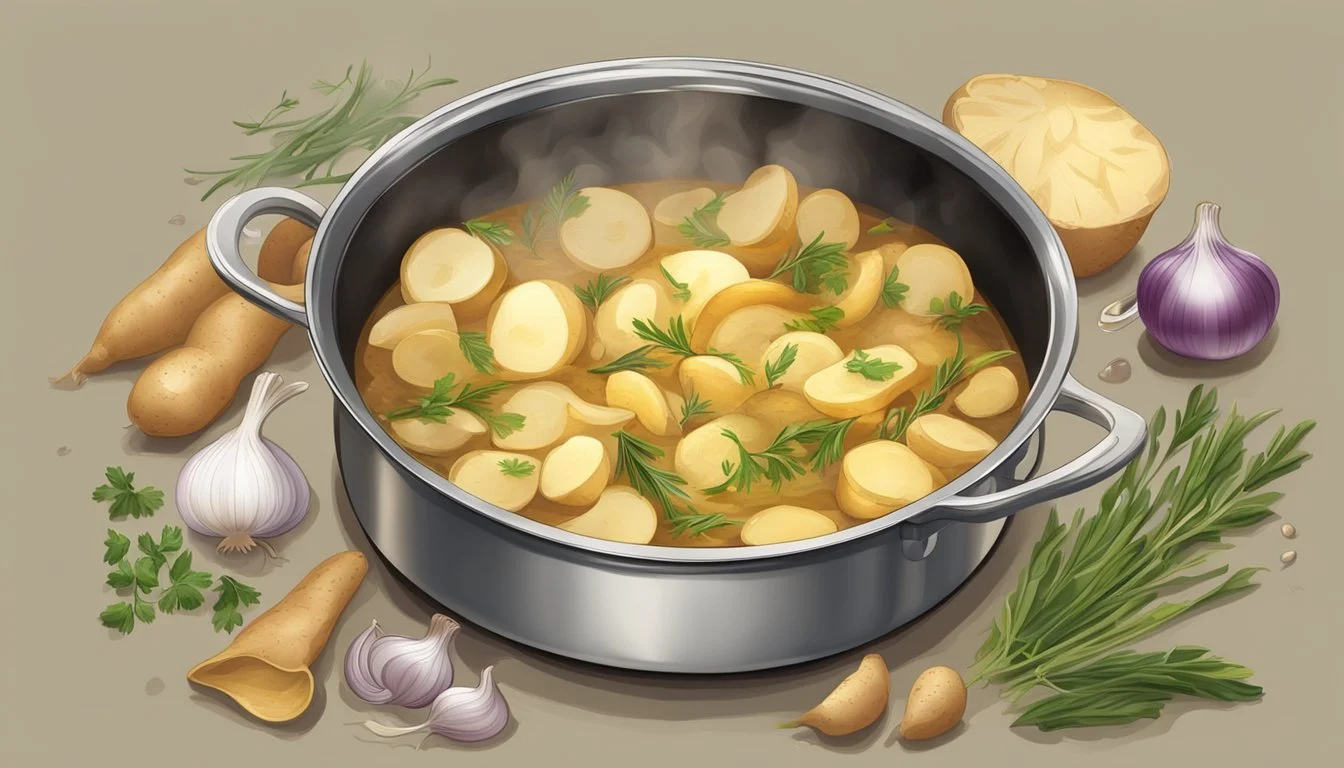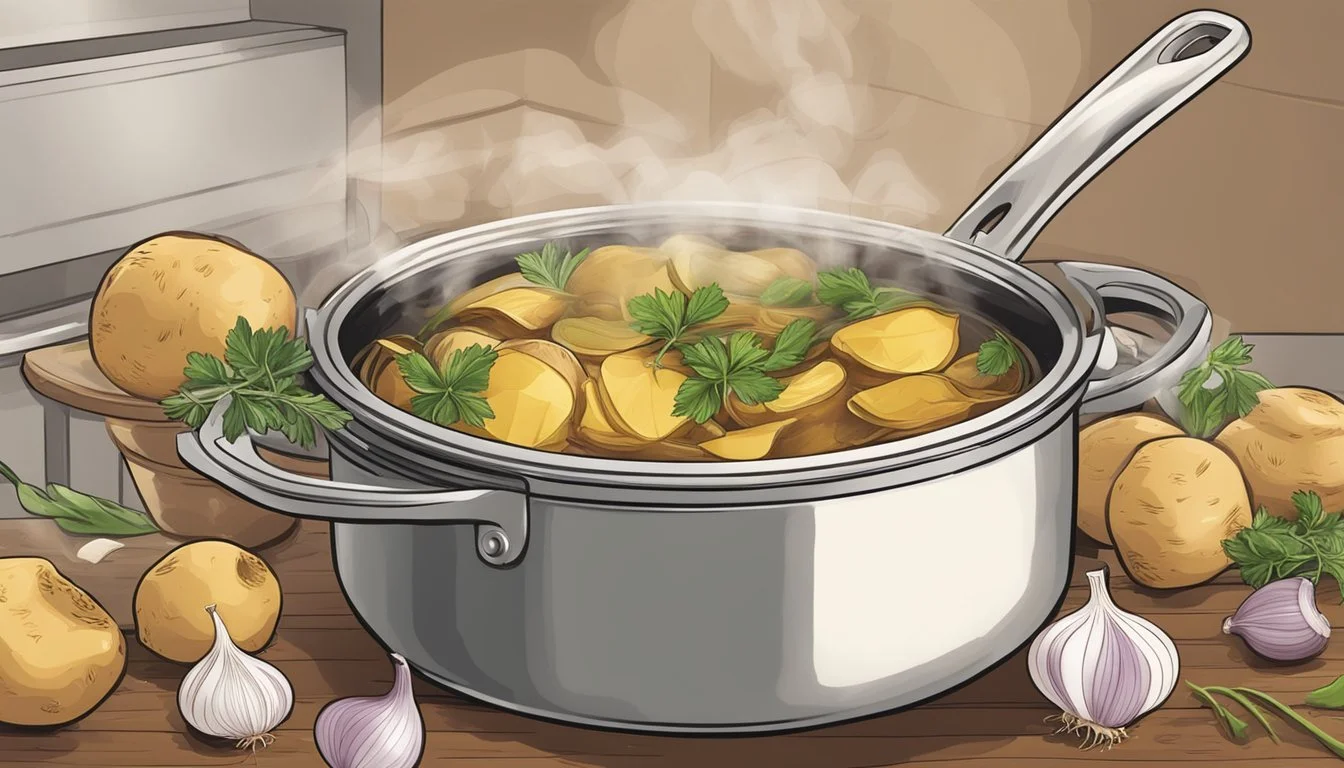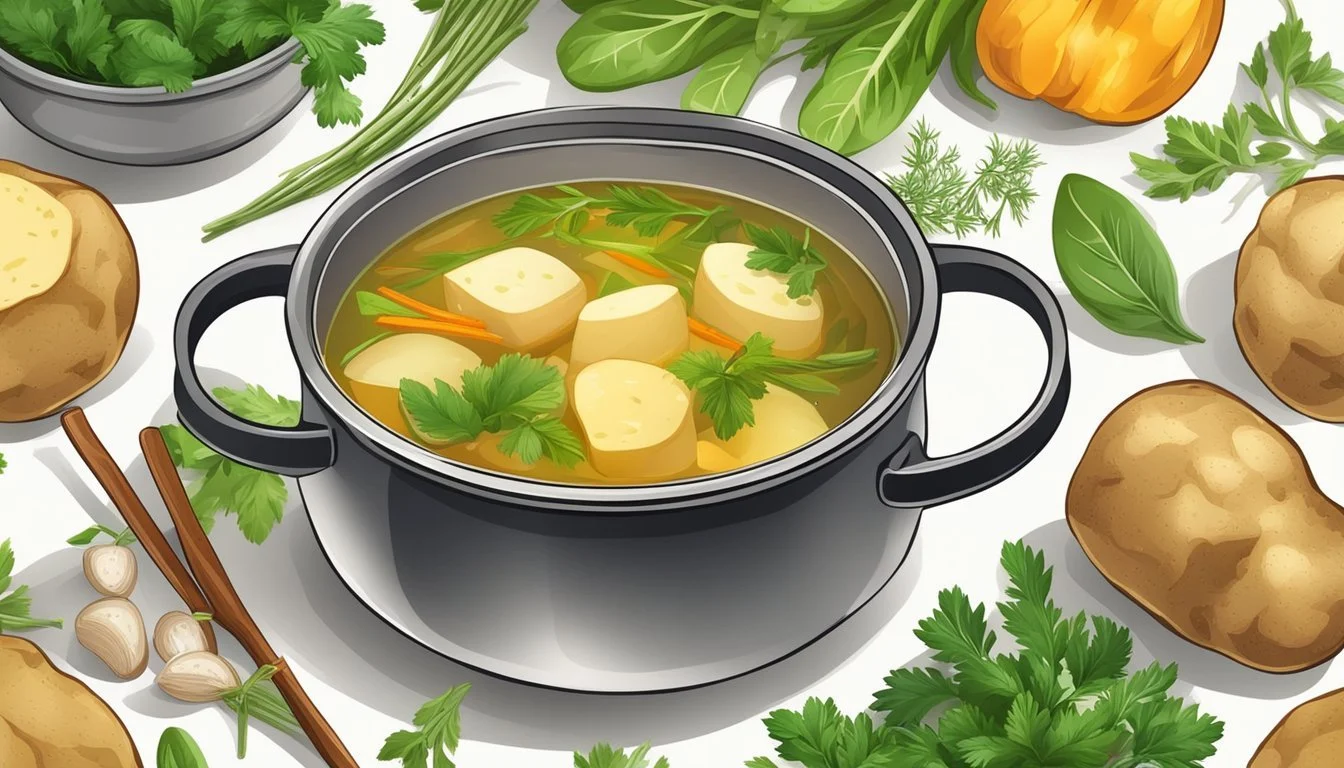Potato Peel Broth
A Hearty, Nutrient-Dense Base for Homemade Soups
Potato peel broth emerges as a culinary secret not only for vegetarians but for anyone seeking a health-boosting, nutrient-dense base for their meals. Often discarded as waste, the humble potato peel is a treasure trove of vitamins, minerals, and antioxidants. When simmered into a broth, these peels impart a rich spectrum of nutrients, including potassium, which is essential for maintaining nerve function and muscle health. As awareness grows about food waste and its environmental impact, turning peels into a flavorful broth is both an economical and sustainable kitchen practice, making the most of the whole vegetable.
The process of creating potato peel broth is simple, yet the result is a complex and hearty liquid that is versatile in its use. It can serve as the foundation for soups (What wine goes well with soups?), stews, and sauces, or be enjoyed on its own as a warming drink. Health enthusiasts appreciate this broth for its potential benefits, including supporting hydration and providing a source of essential nutrients without the addition of artificial preservatives or flavorings found in some store-bought stocks.
In a world where conscious eating and health are intertwined, potato peel broth stands out as a health-conscious choice. It fits seamlessly into diet plans that emphasize whole foods and plant-based ingredients. Additionally, for those who seek gluten-free or allergen-friendly options, potato peel broth offers a safe and nutrient-dense alternative to traditional broths that may contain common allergens.
The Nutritional Value of Potato Peel Broth
Potato peel broth harnesses the nutrients often discarded with the skin of potatoes. This broth is a nutrient-dense liquid that offers a range of health benefits due to its constituent vitamins and minerals.
Health Benefits of Potato Peels
Potato peels are rich in fiber, which is beneficial for digestion and can help lower cholesterol levels. They also contain substantial levels of antioxidants, which aid in protecting the body from free radicals. Potato skin, compared to the flesh, has higher concentrations of certain nutrients which are preserved in the broth. Including potato peel broth in the diet can support heart health and may help in preventing certain chronic diseases.
Vitamins and Minerals in Potatoes
Potato skins are excellent sources of essential vitamins and minerals, key amongst them being potassium and iron.
Potassium: A component of what is often referred to as "potassium broth," potato skins are notable for their high potassium content, which is crucial for maintaining electrolyte balance and proper muscle function.
Iron: Potato peels also contribute iron, a mineral necessary for transporting oxygen through the bloodstream.
Additionally, potato peels contribute small amounts of protein, enhancing the overall nutritional profile of potato peel broth. They also possess various B vitamins and vitamin C, although some of these may be lost during the boiling process. Nevertheless, the minerals, which are more stable under heat, remain and enrich the broth.
By using the peels, the broth becomes a thrifty and healthful way to utilize the entirety of potatoes, minimizing waste while maximizing nutritional gain.
Essential Ingredients for Potato Peel Broth
Creating a nutrient-dense potato peel broth starts with selecting high-quality vegetables and enhancing the natural flavors with the right herbs and seasonings. By focusing on these essentials, one can ensure that the broth is both healthful and hearty.
Selecting Quality Vegetables
When crafting a vegetable broth, it is imperative to use fresh and organically grown vegetables to maximize the nutrient content and flavor. The base vegetables for a potato peel broth are:
Potatoes: Choose large, healthy potatoes. Their peels are the main ingredient and should be thoroughly washed.
Carrots: Integrating carrots adds sweetness and vitamins.
Onion: A quartered onion brings a depth of flavor.
Celery: A stalk of celery aids in creating a balanced savory note.
Garlic: A couple of cloves of garlic will infuse the broth with aroma and health benefits.
These vegetables form a solid foundation of vitamins and nutrients that are essential to a good vegetable broth.
Herbs and Seasonings for Enhanced Flavor
Beyond the vegetables, herbs and seasonings are pivotal for achieving a well-rounded taste:
Parsley: A few sprigs help to brighten the broth.
Salt: Unrefined sea salt is preferable for its minerals.
Pepper: Freshly ground pepper adds a necessary piquancy.
Optional herbs and spices: Depending on personal preference, one may add thyme, bay leaves, or other aromatic herbs in the last few minutes of cooking.
Consistently, the herbs and seasonings should be adjusted to taste, without overwhelming the delicate flavor of the vegetables.
Cooking Techniques
Crafting a nutritious and flavorful potato peel broth requires precise cooking methods. Mastering these techniques allows one to extract the full range of flavors and nutrients from simple ingredients.
Optimal Simmering Times for Richness
A crucial aspect for developing the broth's depth is the simmering duration. Potato peel broth benefits from a range of 45 minutes to 1 1/2 hours of simmering time. A shorter period is sufficient for a light broth, while a longer simmer allows for a richer taste and more nutrient extraction. Always ensure that potato peels and other vegetables remain submerged, adding more water if needed. Final seasoning adjustments should be done towards the end of the cooking process to ensure a well-balanced flavor profile.
Using Kitchen Equipment Effectively
When preparing potato peel broth, it is essential to use the right tools. Start with a large, heavy-bottomed stove-top pot that distributes heat evenly and prevents scorching. This vessel should be large enough to hold all ingredients with sufficient water coverage. For a smoother consistency, an immersion blender can be used after the initial cooking to further break down vegetables and peels. However, for a clear broth, simply strain the liquid to remove solids. It's imperative to use the immersion blender with caution, ensuring everything is fully cooked to prevent damaging the appliance and achieving a consistently smooth texture.
Versatile Uses of Potato Peel Broth
Potato peel broth serves as a hearty and nutrient-dense base that introduces depth of flavor and nutritional value to various dishes. It can be adapted to suit diverse culinary preferences through straightforward modifications.
Incorporating Broth into Various Dishes
Potato peel broth provides an excellent foundation for a range of soups, adding richness and a subtle earthy undertone. A classic potato soup can be elevated by using this broth, amplifying its inherent potato flavor. Similarly, it forms a robust base for vegetable soup, where it complements and enhances the medley of vegetable flavors. For a twist on traditional recipes, replacing standard broth with potato peel broth in chickpea noodle soup can introduce an unexpected layer of flavor, offering a satisfying and comforting meal.
When it comes to pasta dishes, the broth can be used to cook pasta, lending a unique taste that water cannot provide. It can also serve as the liquid component in the sauce, adding complexity and tying the ingredients together cohesively.
Serving Suggestions:
Use as a base in stews for a thicker, more flavorful sauce.
Cook grains like rice or quinoa in the broth to infuse them with a rich taste.
Creative Variations for Customization
The versatility of potato peel broth allows for creative customizations to suit any palate. One can introduce various herbs and spices to the broth to align it with the culinary profile of their choice. Infusing the broth with rosemary or thyme can tailor it for more rustic, comfort dishes, while lemongrass or ginger adds an Asian-inspired twist.
For those seeking to enhance the broth further, the addition of roasted garlic or caramelized onions can deepen the flavors, creating a more complex base for soups and sauces. Alternatively, leftovers from other vegetables can be simmered in the broth to increase its nutritional value and to extract a more dynamic range of flavors.
Customization Ideas:
Infuse with bay leaves and peppercorns for a classic aroma.
Mix in sautéed mushrooms for a hearty, umami-rich dimension.
By integrating potato peel broth into these dishes and exploring various customizations, chefs and home cooks alike can craft nutritious and flavorful meals that showcase the humble potato peel's potential.
Storage and Preservation
Proper storage methods for potato peel broth can significantly extend its shelf life, ensuring that this nutrient-dense base remains safe and flavorsome for future meals.
Refrigeration Best Practices
When storing potato peel broth in the refrigerator, it is crucial to let the broth cool to room temperature before placing it in a sealed container. A glass container or BPA-free plastic is preferable to maintain the broth's quality. They should label the container with the date of storage. The broth can be kept in the refrigerator for up to 5 days.
Cooling: Allow to reach room temperature before refrigeration.
Containers: Use glass or BPA-free plastic.
Labeling: Mark with storage date.
Duration: Store for up to 5 days.
Freezing for Long-Term Storage
For longer storage, potato peel broth can be frozen. One should pour the cooled broth into freezer-safe bags or containers, leaving some space to allow for expansion. These ziplock bags can be laid flat in the freezer to save space. When stored this way, the broth can be frozen for up to 6 months, maintaining its nutritional quality. It is important to adequately label each bag with the date.
Containers: Use freezer-safe bags or containers.
Space: Leave room for expansion.
Organization: Lay bags flat to save freezer space.
Labeling: Clearly mark with the storage date.
Duration: Freeze for up to 6 months.
Customizing for Dietary Preferences
A potato peel broth can be tailored to meet various dietary needs, ensuring a delicious and nutritious base that aligns with individual health requirements and taste preferences.
Adapting Recipes for Vegetarian and Vegan Diets
For vegetarians, potato peel broth already serves as a suitable option as it is inherently plant-based. Vegans can further customize the broth by using any type of vegetable oil or vegan butter instead of traditional dairy products for sautéing any additional vegetables. Adding nutritional yeast or vegan parmesan cheese can provide a savory, cheese-like flavor, making a more complex and satisfying broth.
Vegan-Friendly Ingredients:
Oils: Olive, coconut, or avocado oil
Savory boost: Nutritional yeast or vegan parmesan
Umami flavor: Kombu seaweed or mushrooms
Allergy-Friendly Substitutions
Individuals with allergies can modify the broth by omitting ingredients that pose a risk. For instance, if gluten is a concern, ensure that any added seasoning or bouillon is certified gluten-free. Those with a soy allergy should avoid soy-based sauces, and instead may use a pinch of sea salt or coconut aminos.
Common Allergens & Substitutes:
Allergen Substitute Gluten Gluten-free seasonings Soy Coconut aminos, sea salt Dairy Nutritional yeast, olive oil
By paying attention to the specific needs of the intended dietary preferences, cooks can create a potato peel broth that not only nourishes the body but also abides by the diners' dietary restrictions.
Tips for Enhancing Flavor
The aroma and taste of potato peel broth can be substantially boosted by the strategic use of seasonings and techniques that develop umami flavors, especially in a plant-based context.
Seasoning Combinations for Depth
When it comes to layering flavors in potato peel broth, incorporating a variety of seasonings can significantly enhance the broth’s depth. A starting point can be a classic mirepoix—onions, celery, and carrots—sautéed in olive oil to release their natural sweetness. To this base, one might add combinations of sea salt and black pepper for foundational seasoning, along with an array of spices and fresh herbs for complexity.
A well-balanced mix may include Italian seasoning, a blend of oregano, thyme, rosemary, and basil, which complements the neutral taste of potato peels. Fresh herbs like parsley and rosemary can also be tied into a bouquet garni and simmered within the broth for infused flavors.
Essential Seasonings Quantity Recommendations Sea Salt To taste; start with a pinch Black Pepper (freshly ground) To taste; start with a pinch Italian Seasoning 1 teaspoon per quart of water Fresh Herbs (e.g., parsley, rosemary) A handful, tied into a bouquet garni
Creating Umami in Plant-Based Broths
Umami, often described as the fifth taste, imparts a rich and savory flavor to dishes that is deeply satisfying. To naturally create umami in potato peel broth, one might incorporate ingredients rich in glutamates. Tomato paste, dried mushrooms, or a splash of soy sauce or tamari can be added to the simmering broth to enhance umami. Additionally, a touch of lemon juice can brighten the broth and bring the savory notes to the forefront without overwhelming the palate.
Here's a concise list of umami-rich add-ins for a plant-based potato peel broth:
Tomato paste: 1 tablespoon per quart of water
Dried mushrooms: ½ cup, rehydrated and minced
Soy sauce/Tamari: 1 tablespoon per quart of water
Lemon juice: A squeeze to finish, before serving
Health Considerations
In considering the health aspects of potato peel broth, one should focus on the nutritional benefits while managing sodium and fat content for overall wellness. This broth can be part of a wholesome diet due to the nutrient density of potato peels.
Reducing Sodium and Fat
Potato peel broth typically contains low levels of fat, and its sodium content can be controlled during preparation. To reduce sodium:
Use fresh herbs and spices instead of salt for flavor enhancements.
Choose low-sodium or homemade stock as the broth base.
Fat reduction strategies include:
Skimming off fat that rises to the top after boiling.
Avoiding the addition of high-fat ingredients like oils or butters.
Impact of Broth on Digestive Health
Potato peels are a source of dietary fiber, which may aid in digestive health by:
Promoting regularity in bowel movements.
Supporting a healthy gut microbiome through the proliferation of beneficial bacteria.
Potato peel broth contains potassium and other nutrients while being light on the stomach, making it a comforting option for those with digestive sensitivities.
Financial and Environmental Benefits
Potato peel broth represents a unique convergence of financial prudence and environmental sustainability. It turns kitchen scraps into a valuable food source, demonstrating the practical benefits of a less wasteful lifestyle.
Economic Advantages of Homemade Broth
Homemade broth made from potato peels is a perfect example of how affordable and inexpensive alternatives can replace store-bought products. By utilizing peels that would otherwise be discarded, individuals can save on groceries. Here's a simple breakdown:
Cost of Commercial Broth: $2 - $4 per quart
Cost of Homemade Peel Broth: Pennies per quart, utilizing only leftover peels and basic seasonings.
The price difference clearly shows the economic benefits, but the homemade version also often contains no artificial preservatives, making it a high-quality option as well.
Reducing Food Waste with Leftovers
Turning leftovers into a nutritious broth addresses one of the significant issues in the food industry: waste. The environmental impact of reusing potato peels includes:
Decreased landfill waste: Less organic matter ending up as refuse.
Reduced production costs: Lower demand for commercially produced broths means a reduction in resources used for manufacturing and packaging.
Moreover, by promoting the reuse of kitchen scraps, households can diminish their carbon footprint, contributing to a more eco-friendly food system.











